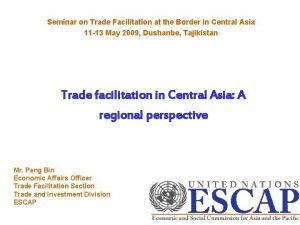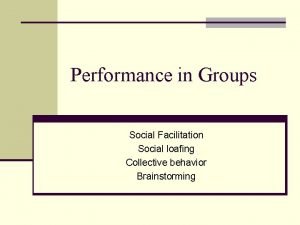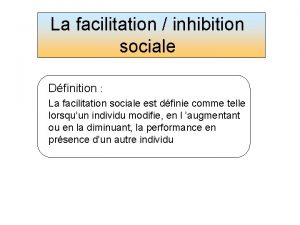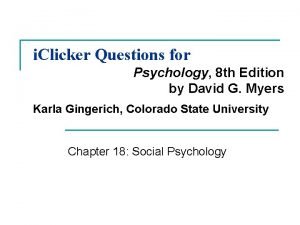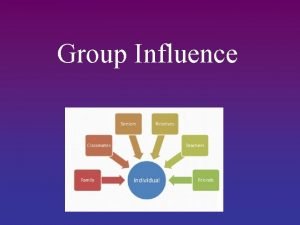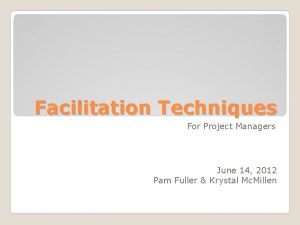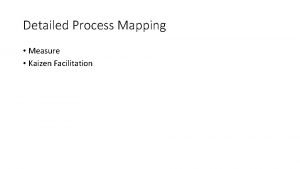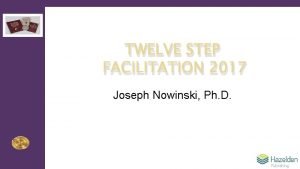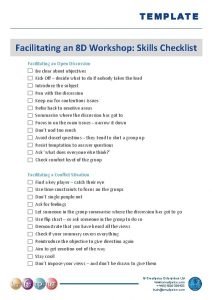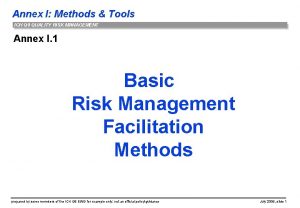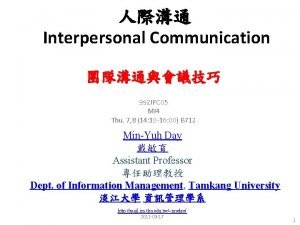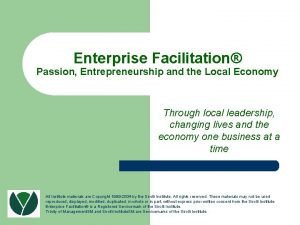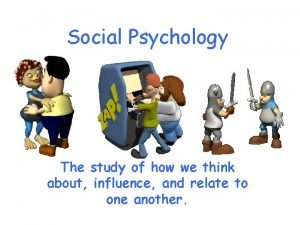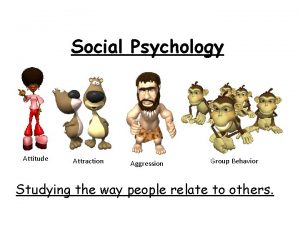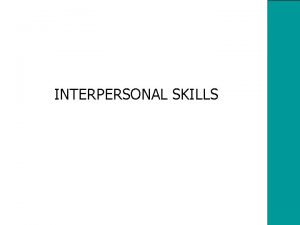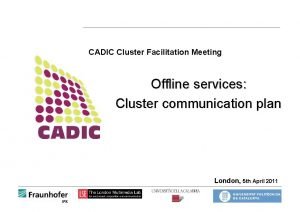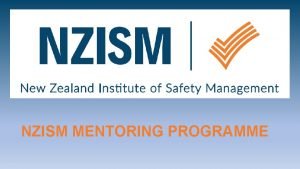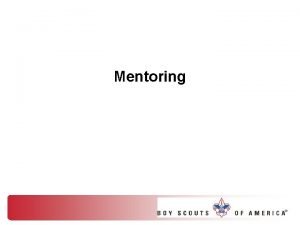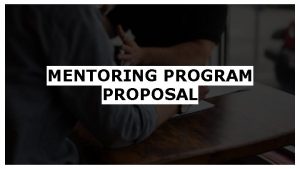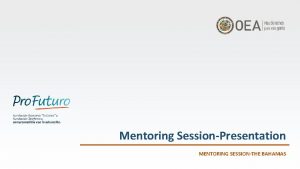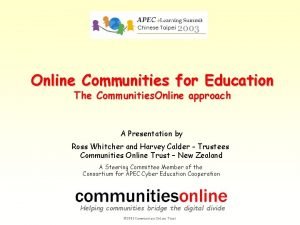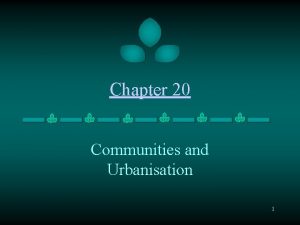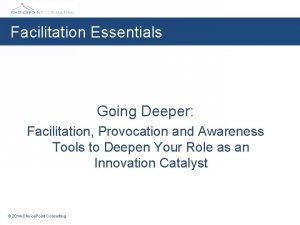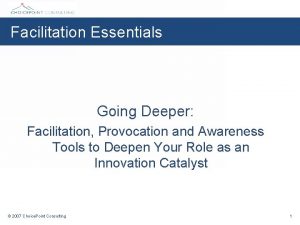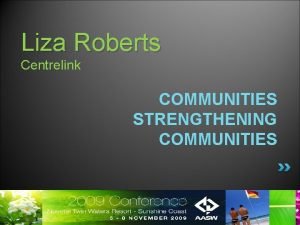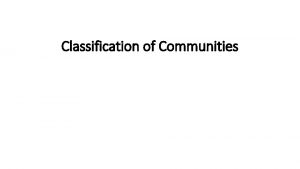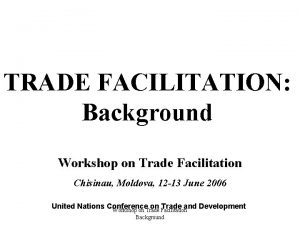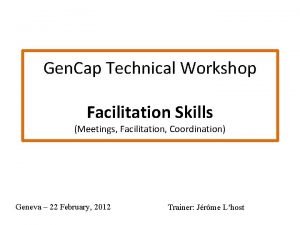Online Mentoring and Facilitation for Online Communities and




















































































- Slides: 84

Online Mentoring and Facilitation for Online Communities and Cross Cultural Exchanges Dr. Curtis J. Bonk Indiana University Course. Share http: //php. indiana. edu/~cjbonk@indiana. edu

What Roles of Online Instructor? ? ? – facilitator, hostess, chair, host, lecturer, tutor, facilitator, mediator, mentor, provocateur, observer, participant, assistant, organizer (Paulsen, 1995; Selinger, 1999)

Mason’s (1991) 3 Roles • Organizational—set agenda, objectives, timetable, procedural rules – Patience, vary things, spur discussion, invites • Social—welcome, thank, provide feedback, and set generally positive tone – Reinforce good things, invite to be candid • Intellectual—probe, ask q’s, refocus, set goals, weave comments, synthesize comments – Know when to summarize and to leave alone

Four Key Hats of Instructors: – Technical—do students have basics? Does their equipment work? Passwords work? – Managerial—Do students understand the assignments and course structure? – Pedagogical—How are students interacting, summarizing, debating, thinking? –Social—What is the general tone? Is there a human side to this course? Joking allowed? – (Ashton, Roberts, & Teles, 1999)

Let’s Explore These Hats Again With Specific Examples! –Technical –Social –Managerial –Pedagogical

Technological Hat • Address tool/system familiarity • Require early assignment to test technology • Have orientation task, early training • Be flexible, smooth out problems • Plan, test, support

Social Hat • Create community, set tone, motivate • Welcome, thank, invite, reinforce positives • Foster shared knowledge • Support humor and conversational tone • Use tools such as cafes, profiles, pictures • Invite to be candid

Managerial Hat • Set agenda, timetable/calendar, assignment page • Set objectives, clear times, due dates, expectations • Explain rules, assignments, intended audiences • Assign teams and coordinate meeting times • Monitor discussions and track logins • Provide weekly feedback and class updates • Manage gradebooks; post grading rubrics

Pedagogical Hat • Use PBL or inquiry environment • Refer to outside resources and experts • Coordinate student interaction, team collaboration • Assign roles, set goals, foster peer feedback • Ask probing questions, refocus, nudge, instruct • Scaffold, give advice, mentor • Weave, synthesize, link ideas, provide overviews • Know when to intervene and when to leave alone

How to Combine these Roles?

E-Moderator • Refers to online teaching and facilitation role. Moderating used to mean to preside over a meeting or a discussion, but in the electronic world, it means more than that. It is all roles combined—to hold meetings, to encourage, to provide information, to question, to summarize, etc. (Collins & Berge, 1997; Gilly Salmon, 2000); see http: //www. emoderators. com/moderators. shtml.

E-Moderating: The Key to Teaching and Learning Online, (Gilly Salmon, (1999) Kogan Page) • • • Know when to stay silent for a few days. Close off unused or unproductive conferences. Provide relevant and purposeful conferences. Provide a variety of conference topics. Deal promptly with dominance, harassment, and excessive lurking. • Summarize and archive often.

e. Moderators. com Web Site http: //www. emoderators. com/moderators. shtml#mod

Pedagogical Recommendations (Berge, 1995, The role of the online instructor/facilitator) • Don’t expect too much/thread • Draw attention to conflicting views • Do not lecture (Long, coherent sequence of comments yields silence) • Request responses within set time • Maintain non-authoritarian style • Promote private conversations

Social Recommendations (Berge, 1995, The role of the online instructor/facilitator) • Guard against fear or public ridicule • Be accepting of lurkers • Do not ignore bad discussant behavior— privately request change • Use introductions • Limit use of humor and sarcasm • Praise behavior you seek

Managerial Recommendations (Berge, 1995, The role of the online instructor/facilitator) • Distribute lists of participants • Provide timely administrative info— books, enrollment, counseling, etc. • Change procedures that are not working • Change misplaced subject headings • Decisively end discussion sessions • Don’t overload

Other Hats

Personal Learning Trainer • Learners need a personal trainer to lead them through materials and networks, identify relevant materials and advisors and ways to move forward (Mason, 1998; Salmon, 2000).

Online Concierge • To provide support and information on request (perhaps a map of the area…) (Gilly Salmon, 2000).

Online Conductor • The pulling together of a variety of resources as people as in an orchestra to produce beautiful integrated sound or perhaps electrical current conductors if your conferences are effective and flow along, there will be energy, excitement, and power (Gilly Salmon, 2000).

E-Police • While one hopes you will not call yourself this nor find the need to make laws and enforce them, you will need some Code of Practice or set procedures, and protocols for e-moderators (Gilly Salmon, 2000).

Convener • A term that is used especially with online conferences and courses where there is a fairly side audience (Gilly Salmon, 2000).

Online Negotiator • Where knowledge construction online is desired, the key role for the e-moderator is one of negotiating the meaning of activities and information thought online discussion and construction (Gilly Salmon, 2000).

Online Host • The social role of online working is important so there may be a need for a social host or hostess. They do not need to run social events online (though they may) but ensure everyone is greeted and introduced to others with like-minded interests (Gilly Salmon, 2000).

Other Hats • • Weaver—linking comments/threads Tutor—individualized attention Participant—joint learner Provocateur—stir the pot (& calm flames) Observer—watch ideas and events unfold Mentor—personally apprentice students Community Organizer—keep system going

Still More Hats Assistant Devil’s advocate Editor Expert Filter Firefighter Facilitator Gardener Helper Lecturer Marketer Mediator Priest Promoter

How form a community…? ? ?

A learning community is a group of individuals interested in a common topic or area, who engage in knowledge related transactions as well as transformations within it. They take advantage of the opportunity to exchange ideas and learn collectively. (Bonk & Wisher, 2000; Fulton & Riel, 1999)

Factors in Creating any Community (1) membership/identity (2) influence (3) fulfill of indiv needs/rewards (4) shared events & emotional connections (Mc. Millan & Chavis, 1986). History, stories, expression, identity, participation, respect, autonomy, celebration, team building, shape group, Schwier, 1999)

Help Categorize the Degree of Online Community (Chao, 1999) (1) self-disclosures, time, energy (2) refer to norms, rules, others (3) give and receive info, express need, thank, criticize, suggest (4) special stories, symbols, events, identify spiritual bonds

How Facilitate Online Community? • • • Safety: Establish safe environment Tone: Flexible, inviting, positive, respect Personal: Self-disclosures, open, stories telling Sharing: Share frustrations, celebrations, etc Collaboration: Camaraderie/empathy Common language: conversational chat space • Task completion: set milestones & grp goals • Other: Meaningful, choice, simple, purpose. . .

Web Facilitation Advice from Vanessa Dennen: San Diego State University

Research on Nine Online Courses • 9 case studies of online classes using asynchronous discussion • Topics: sociology, history, communications, writing, library science, technology, counseling • Range of class size: 15 - 106 • Level: survey, upper undergraduate, and graduate • Tools: custom and commercial • Private, semi-public, and public discussion areas

Goals, Needs & Extrinsic Motivation • Participation was higher in cases where students had a clear goal or need and extrinsic motivation to participate • Sample instances – Required assignment with feedback/grade – Need help – Need to understand material • Few students participated merely because they could

Unique or Perspective-based Discussion • Greater dialogue was generated when students were encouraged or required to share their own perspectives or unique examples • Fact-based questioning strategies did not work well • Students used perspectives and examples to make meaning of material

Guidelines and Feedback • Qualitative discussion guidelines and feedback helped students know what their participation should look like • Quantitative discussion guidelines and feedback comforted students and was readily understood by them • Feedback of both varieties was needed at regular intervals, although the qualitative feedback need not be individualized

Deadlines • Deadlines motivated participation – Message counts increased in the days immediately preceding a deadline • Deadlines inhibited dialogue – Students posted messages but did not discuss – Too much lag time between initial messages and responses

Modeling • Instructor modeling increased the likelihood of student messages meeting quality and content expectations • Modeling was more effective than guidelines

Motivation and Presence • Instructor must find balanced presence in course to truly motivate students to learn and perform their best • Too little instructor presence can cause low levels of student involvement • Too much instructor presence can cause perfunctory and/or uninspired student involvement

Poor Instructors • Little or no feedback given • Always authoritative • Kept narrow focus of what was relevant • Created tangential discussions • Only used “ultimate” deadlines Good Instructors • Provided regular qual/quant feedback • Participated as peer • Allowed perspective sharing • Tied discussion to grades, other assns. • Used incremental deadlines

More on How to Facilitate. . . • • Find common ref pt--mission, purpose, need Guide to negotiate/co-construct meaning Establish some common practices or rituals Hold regularly scheduled events--chats, tours Create opportunities to contribute/develop Apply course to lived experiences Keep simple, give choice, build respect & tension

Facilitating Electronic Discussion • • Provide Guidelines and Structure Weave and Summarize Weekly Be patient, prompt, and clear Assign Due Dates, Times, and Points Constantly Monitor, Converse not Dictate Assign Buddies/Pals or Include Mentoring Extend Beyond Class with Peers/Practitioners

Online Mentoring and Assistance Online Twelve forms of electronic learning mentoring and assistance (Bonk & Kim, 1998; Tharp, 1993; Bonk et al. , 2001)


1. Social (and cognitive) Acknowledgement: "Hello. . . , " "I agree with everything said so far. . . , " "Wow, what a case, " "This case certainly has provoked a lot of discussion. . . , " "Glad you could join us. . . "

2. Questioning: "What is the name of this concept. . . ? , " "Another reason for this might be. . . ? , " "An example of this is. . . , " "In contrast to this might be. . . , ""What else might be important here. . . ? , " "Who can tell me. . ? , " "How might the teacher. . ? . " "What is the real problem here. . . ? , " "How is this related to. . . ? , “, "Can you justify this? "

3. Direct Instruction: "I think in class we mentioned that. . . , " Chapter ‘X’ talks about. . . , " "Remember back to the first week of the semester when we went over ‘X’ which indicated that. . . "

4. Modeling/Examples: "I think I solved this sort of problem once when I. . . , " "Remember that video we saw on ‘X’ wherein ‘Y’ decided to. . . , " "Doesn't ‘X’ give insight into this problem in case ‘Z’ when he/she said. . . "

5. Feedback/Praise: "Wow, I'm impressed. . . , " "That shows real insight into. . . , " "Are you sure you have considered. . . , " "Thanks for responding to ‘X’. . . , " "I have yet to see you or anyone mention. . . "

6. Cognitive Task Structuring: "You know, the task asks you to do. . . , " "Ok, as was required, you should now summarize the peer responses that you have received. . . , " "How might the textbook authors have solved this case. "

7. Cognitive Elaborations/Explanations: "Provide more information here that explains your rationale, " "Please clarify what you mean by. . . , " "I'm just not sure what you mean by. . . , " "Please evaluate this solution a little more carefully. "

8. Push to Explore: "You might want to write to Dr. ‘XYZ’ for. . . , " "You might want to do an ERIC search on this topic. . . , " "Perhaps there is a URL on the Web that addresses this topic. . . "

9. Fostering Reflection/Self Awareness: "Restate again what the teacher did here, " "How have you seen this before? , " "When you took over this class, what was the first thing you did? , " "Describe how your teaching philosophy will vary from this. . . , " "How might an expert teacher handle this situation? "

10. Encouraging Articulation/Dialogue Prompting: "What was the problem solving process the teacher faced here? , " "Does anyone have a counterpoint or alternative to this situation? , " "Can someone give me three good reasons why. . . , " "It still seems like something is missing here, I just can't put my finger on it. "

11. General Advice/Scaffolding/Suggestions: "If I were in her shoes, I would. . . , " "Perhaps I would think twice about putting these people into. . . , " "I know that I would first. . . , " "How totally ridiculous this all is; certainly the “person” should be able to provide some. . . "

12. Management (via private e-mail or discussion): "Don't just criticize. . please be sincere when you respond to your peers, " "If you had put your case in on time, you would have gotten more feedback. " "If you do this again, we will have to take away your privileges. "

TICKIT Staff Mentoring (IU Study) (direct instruction and explanations = 0) (Bonk, Ehman, & Hixon, 2000)

Mentoring in COW

Bill Brescia’s (2000) Doc Research on Online Mentoring • Simple feedback vital, student clarification too • Want professor opinions & resource suggestions • Modeling useful at start; summing at end of semester • Most students saw value of reflection, not all • Student resistance to reading long posts • Students resistant to weekend posting; continued posts • Changing subject link impt to facilitating discussion

Conferencing On Web (COW) Three Basic Levels: 1. Conference (public or private) 2. Topic (e. g. , special education) 3. Conversation (e. g. , reading rewards)






Justified Statement (Finnish) 3. Author: Kirsi Date: Mar. 6 8: 11 AM 1998 Why not let the student study math further by himself and the teacher could help him whenever the teacher has time. At least some of the math study books are so designed that one page has examples that teach you how to solve the problem and then on the next page there are exercises. I personally hate being said 'wait' since when I'm interested in something I want to go on and learn more and not wait. This way I think the child learns to be responsible of his own learning. If I quote dear mr Vygotsky here again, the teacher should be sensitive to see where the child's proximate zone of development is and to help him 'over' it. The teacher's task is not to try to keep the child on the level he has reached but to help him learn more if he is interested…

Unjustified Statements (US) 24. Author: Katherine Date: Apr. 27 3: 12 AM 1998 I agree with you that technology is definitely taking a large part in the classroom and will more so in the future with all the technological advances that will be to come but I don't believe that it could actually take over the role of a teacher…but in my opinion will never take over the role of a teacher. 25. Author: Jason Date: Apr. 28 1: 47 PM 1998 I feel technology will never over take the role of the teacher. . . I feel however, this is just help us teachers out and be just another way for us to explain new work to the children. No matter how advanced technology gets it will never be able to. . . 26. Author: Daniel Date: Apr. 30 0: 11 AM 1998 I believe that the role of the teacher is being changed by computers, but the computer will never totally replace the teacher. . . I believe that the computers will eventually make teaching easier for us and that most of the children's work will be done on computers. But I believe that there will always be the need for the teacher.








Vertical Mentoring Examples 9. Author: Jerry Cochey ( Mentor) Date: Mar. 11 1: 46 PM 1998 To shift from teacher centered classrooms to child centered classrooms and learning takes time, patience and a commitment to the idea that students are responsible for their own learning. Even in this age of enlightenment(? ), we think that a quiet, teacher controlled classroom shows learning, while research shows that active, talking, sharing of learning experiences with peers is more productive. Be patient, it takes a long time to have students change to being responsible for their own. 8. Author: Jerry Cochey ( Mentor) Date: Mar. 11 1: 54 PM 1998 As each of you have noted, teachers need to continue to supervise/coordinate learning. How much freedom is given to students depends on what you know they can accomplish without direct supervision. Master teachers select what methods are appropriate and effect for a given student or group of students.

Horizontal Finnish Mentoring 12. Author: Leena Date: Mar. 30 11: 52 AM 1998 This case is something I feel very close to. I have been trying struggle with finding ways to be a teacher in a new way, trying to think everything from the students' perspective, to challenge my own old traditions of teaching and try to seek ways which the I could find ways of studying things together with the students. What really puzzles me is that these different "projects" have had such extremely different lives. I definitely loath the idea that a teacher would "send the students to the library and come back with a mind map" with the only purpose of having an easy time. But, the problem is that even the simplest thing such as a mindmap, which I've used quite often myself, can lead to so many different kinds of results. I've learnt during my short stay in the Department of Teacher Education. . . What I really don't know yet is how to be a proper supporter of these processes for students. I have succeeded in many contexts but feel that there are so many areas to achieve. In the end, finding the "right" path is really a matter of mutual understanding between students and teachers, open discussion, with mutual trust. Without such dialogue, nothing can be developed. - Leena

Frequent Case Topics

Problems Solved By COW • Student isolation in field experiences • Lack of community/dialogue among teacher education participants • Disconnectedness between class and field exper • Limited reflective practices of novice teachers • Need for appreciation of multiple perspectives

Overall Major Findings • COW enhanced student learning – provided a link between classroom and field – encouraged learning about technology • COW extended student learning – students got feedback from outside their immediate community – students saw international perspective • COW transformed student learning – students took ownership for learning – students co-constructed knowledge base

Qualitative Themes Continued. . . • Students were attracted to cases that… – had interesting titles – were on familiar topics – were on controversial topics – they had opinions about • Peer feedback was appreciated but not deep • Mentor feedback was apprec. & motivating

Types of Online Mentoring (Vince Rowe (2000), e-learning, 1(2), pp. 42 -43. • • Live interactive chat Delayed/async Discussions E-mail—Q&A, interviews, etc. FAQs—libraries of previous q&a’s Message Boards—post tips, titles, sources, etc. Assignments/Assessment with expert review Staged Events—online conferences, online speeches, impersonalizations, mock trials, etc.

Sample Free K-12 Online Mentoring

Mentoring in the Military (AC 3 -DL)

So, what will you do now?
 Secondary succession facts
Secondary succession facts Social inhibitoon
Social inhibitoon Business facilitation program visa
Business facilitation program visa Social facilitation in sports
Social facilitation in sports Group polarization psychology definition
Group polarization psychology definition Trade facilitation meaning
Trade facilitation meaning How to remember pnf patterns
How to remember pnf patterns Facilitation among species
Facilitation among species Social facilitation
Social facilitation Inhibition sociale
Inhibition sociale The excitement that lingers after a frightening event
The excitement that lingers after a frightening event Influence
Influence Project management facilitation techniques
Project management facilitation techniques Process mapping workshop facilitation
Process mapping workshop facilitation Trade facilitation meaning
Trade facilitation meaning Group facilitation skills ppt
Group facilitation skills ppt 12 step facilitation handbook
12 step facilitation handbook Workshop checklist template
Workshop checklist template Facilitator teaching style examples
Facilitator teaching style examples Interpersonal language
Interpersonal language Thank you facilitator
Thank you facilitator Thank you message to training facilitator
Thank you message to training facilitator Thank you message for the facilitator
Thank you message for the facilitator Trade facilitation support program
Trade facilitation support program Facilitation model
Facilitation model Basic risk management facilitation methods
Basic risk management facilitation methods Trade facilitation indicators
Trade facilitation indicators Interpersonal facilitation
Interpersonal facilitation Facilitation methods for adults
Facilitation methods for adults Enterprise facilitation
Enterprise facilitation Zoom facilitation tips
Zoom facilitation tips Social psychology examples
Social psychology examples Social facilitation
Social facilitation Interpersonal facilitation
Interpersonal facilitation Primary care practice facilitation curriculum
Primary care practice facilitation curriculum Trade finance facilitation program
Trade finance facilitation program Developing facilitation skills
Developing facilitation skills Oecd trade facilitation indicators
Oecd trade facilitation indicators Cp facilitation cleaning
Cp facilitation cleaning How to facilitate a group
How to facilitate a group Cluster facilitation team
Cluster facilitation team Facilitator approach
Facilitator approach Fspos
Fspos Novell typiska drag
Novell typiska drag Nationell inriktning för artificiell intelligens
Nationell inriktning för artificiell intelligens Returpilarna
Returpilarna Varför kallas perioden 1918-1939 för mellankrigstiden?
Varför kallas perioden 1918-1939 för mellankrigstiden? En lathund för arbete med kontinuitetshantering
En lathund för arbete med kontinuitetshantering Underlag för särskild löneskatt på pensionskostnader
Underlag för särskild löneskatt på pensionskostnader Tidböcker
Tidböcker Anatomi organ reproduksi
Anatomi organ reproduksi Förklara densitet för barn
Förklara densitet för barn Datorkunskap för nybörjare
Datorkunskap för nybörjare Stig kerman
Stig kerman Debattinlägg mall
Debattinlägg mall Magnetsjukhus
Magnetsjukhus Nyckelkompetenser för livslångt lärande
Nyckelkompetenser för livslångt lärande Påbyggnader för flakfordon
Påbyggnader för flakfordon Arkimedes princip formel
Arkimedes princip formel Offentlig förvaltning
Offentlig förvaltning Lyckans minut erik lindorm analys
Lyckans minut erik lindorm analys Presentera för publik crossboss
Presentera för publik crossboss Vad är ett minoritetsspråk
Vad är ett minoritetsspråk Plats för toran ark
Plats för toran ark Treserva lathund
Treserva lathund Mjälthilus
Mjälthilus Bästa kameran för astrofoto
Bästa kameran för astrofoto Centrum för kunskap och säkerhet
Centrum för kunskap och säkerhet Verifikationsplan
Verifikationsplan Mat för unga idrottare
Mat för unga idrottare Verktyg för automatisering av utbetalningar
Verktyg för automatisering av utbetalningar Rutin för avvikelsehantering
Rutin för avvikelsehantering Smärtskolan kunskap för livet
Smärtskolan kunskap för livet Ministerstyre för och nackdelar
Ministerstyre för och nackdelar Tack för att ni har lyssnat
Tack för att ni har lyssnat Mall för referat
Mall för referat Redogör för vad psykologi är
Redogör för vad psykologi är Stål för stötfångarsystem
Stål för stötfångarsystem Tack för att ni har lyssnat
Tack för att ni har lyssnat Borra hål för knoppar
Borra hål för knoppar Vilken grundregel finns det för tronföljden i sverige?
Vilken grundregel finns det för tronföljden i sverige? R formel
R formel Tack för att ni har lyssnat
Tack för att ni har lyssnat Steg för steg rita
Steg för steg rita Ledningssystem för verksamhetsinformation
Ledningssystem för verksamhetsinformation





